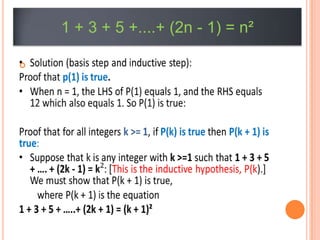
Induction q
- 1. 1 + 3 + 5 +....+ (2n - 1) = n²
- 2. Now the LHS of P(k + 1) is 1 + 3 + 5 + ….. + (2k + 1) = 1 + 3 + 5 +…. + (2k-1) + (2k + 1) by making the next-to-last term explicit = k² + (2k + 1) by inductive hypothesis.
- 3. And the RHS of P(k + 1) is(k + 1)² = k²+ 2k + 1 by basic algebra. k² + (2k + 1) = k²+ 2k + 1 So the left-hand and right-hand sides of P(k+1) equal the same quantity, and thus and thus P(k+1) is true [as was to be shown].
- 4. I NDUCTION Example : HYPOTHESIS 4 + 7 + 10 +- - - - + 3n+2= ½(3n² +5n ) prove by inductive. -assume it is true ( hypothesis ) and then If n= n+1 the sum should be ½ [3(n+1)² +5(n+1). prove it -The term of n+1 = 3(n+1)+2 -The sum of (n+1) = ½(3n² +5n )+ 3(n+1)+2 ½(3n² +5n + 6n+6+4) = ½ [(3n² +6n + 3) + 5n+5 = ½[3(n+1)²+ 5(n+1)] ---> if inductive hypothesis P(n) is true , then P(n+1) must be true
- 5. MATHEMATICAL INDUCTION TO CONSTRUCT PROOFS INVOLVING FORMULAS, DIVISIBILITY PROPERTIES AND INEQUALITIES
- 6. FORMULA : SUMMATION FORMULAE Problem 1: Use mathematical induction to prove that 1 + 2 + 3 + ... + n = n (n + 1) / 2 for all positive integers n. Solution to Problem 1: Let the statement P (n) be 1 + 2 + 3 + ... + n = n (n + 1) / 2 STEP 1: We first show that p (1) is true. Left Side = 1 Right Side = 1 (1 + 1) / 2 = 1 Both sides of the statement are equal hence p (1) is true.
- 7. STEP 2: We now assume that p (k) is true 1 + 2 + 3 + ... + k = k (k + 1) / 2 and show that p (k + 1) is true by adding k + 1 to both sides of the above statement 1 + 2 + 3 + ... + k + (k + 1) = k (k + 1) / 2 + (k + 1) = (k + 1)(k + 2) / 2 The last statement may be written as 1 + 2 + 3 + ... + k + (k + 1) = (k + 1)(k + 2) / 2 Which is the statement p(k + 1).
- 8. PROVING INEQUALITIES n<2ⁿ For all positive integer n Let p(n)=n<2ⁿ Basis step:P(1) is true 1<2¹=2 Inductive step: p(k) is true, then p(k+1) is true P(k)= k<2ᴷ P(k+1)= k+1<2ᴷ ¹ ᴷ Add 1 to both sides K+1 < 2ᴷ+1 <= 2ᴷ+2ᴷ =2.2ᴷ =2ᴷ ᴷ¹ P(k+1) is true
- 9. PROVING DIVISIBILITY Prove n³-n is divisible by 3. n is positve integer Basis step: p(1) is true 1³-1=0 is divisible by 3 Inductive step: p(k) is true P(k)= k³-k is divisible by 3 P(k+1)= (k+1) ³-(k+1) is divisible by 3 P(k+1) ³-(k+1 ) = (k³+3k²+3k+1)- (k+1 ) (k³-k)+3(k²+k)
